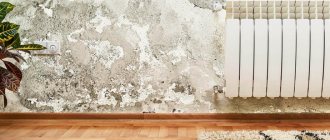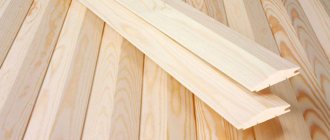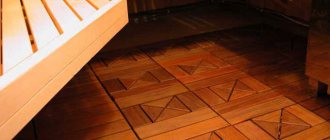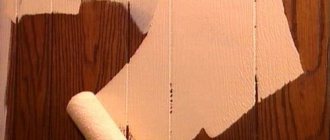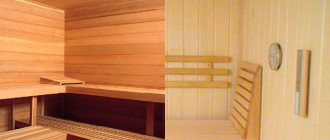Treated lining in the bathhouse
“If you lose your goal, double your efforts”
I am glad to meet you again, dear readers! First of all, I want to wish everyone a Merry Christmas and wish you all your good wishes come true!!!
Today I decided to discuss a subtle, but for many, very sensitive topic. There are many opinions about whether it is necessary to treat the interior lining of a bathhouse. For some, the argument of darkening and rotting of wood is in favor of treatment with special means.
Others are convinced that humidity and temperature provoke fumes from boards coated with “chemicals”, and this cannot be called harmless to health. Still others accept a compromise - the steam room is not treated, but the rest of the premises, yes. So, how to treat the lining in the bathhouse? Let's try to figure it out...
The relevance of the use of protective compounds
There is an opinion that using materials from expensive types of wood and proper ventilation is better than treating wood in a steam room
means of paint and varnish production. This is explained by clogging of pores, the chemical composition of liquids and mastics, and the need to periodically update the coating. The latter cannot be done without mechanical cleaning of the surface of the lining, which damages the wood fibers.
Let's figure out whether it is necessary to process the lining in the steam room. Intensive ventilation of the room really allows you to remove moisture and dry the lining. This helps reduce the risk of mold, mildew and bacteria to a minimum. However, biological damage is not the only phenomenon that leads to the destruction of wood.
In the bathhouse, the temperature rises and falls. Any tree changes in volume because of this, which leads to the appearance of cracks.
Cracks in the lining Source www.svoyidoma.ru
And they become favorable areas for the development of bacteria, fungus and mold. In addition, microvoids quickly become dirty. Without a protective cover, the lining turns black, regardless of its resistance to changing operating conditions. As a result, whether it is necessary to process the lining in a bathhouse is a necessary measure.
Surface care
After performing bath procedures you must:
- Wipe wooden surfaces with a dry cloth.
- Wipe off dirt with a damp cloth. You can use gentle detergents. After this, wipe the surfaces with a dry cloth.
- Ventilate the steam room.
The protective coating should be renewed every 6 months.
To prevent the wooden surfaces inside the steam room from being destroyed due to high humidity, temperature changes, and to prevent mold, mildew, and darkening from appearing on them, you need to treat the wood with a protective compound
It is important to choose a product that will not release harmful substances when heated strongly. After purchasing the composition, you must study the instructions for its application and carry out the processing
When the lining is processed, you must first wait for the antiseptic to dry, and then you can begin bathing procedures.
Types of wood protection products
On trading platforms there is a wide range of materials for covering the inside of a bathhouse. Let's consider the properties of acceptable materials and those that are not recommended to be used. We’ll also decide on the compositions that are best used for walls with ceilings or doors with shelves.
Treatment of steam room walls and ceilings
To understand how to cover the paneling in a steam room, let’s get acquainted with the properties of the material. Wood is destroyed by moisture, temperature changes, and biological life. That is, protective equipment must be antiseptic, resistant to heat and moisture.
Using the lining also leads to surface contamination and fading. This means that the coating must be durable and resistant to washing. It is necessary to consider the materials with which to cover the lining in the bathhouse so that it does not darken.
The effect of lightening wood when working with bleach Source stroimaterials.ru
It is important to pay attention to the composition of the products offered by manufacturers. It must be safe for humans and the environment, not cause allergies, not release toxins at elevated temperatures, and not dissolve in water. The following coating products meet all requirements:
- Antiseptic. A group of similar products is intended for pre-treatment of the base before applying the topcoat. The liquid penetrates deeply into the wood, protecting it from biological damage. But it does not form a protective film that is resistant to mechanical stress, moisture and heat.
Antiseptic for baths Source shoppingator.ru
- Fire retardant. This material reduces the flammability class of the lining. Like antiseptics, the product is not suitable for use as a stand-alone finish.
Fire protection for wood Source reklamasevproduction.s3.amazonaws.com
- Impregnation. The finishing material meets the requirements of a finishing coating for a steam room. It is breathable, penetrates deeply into the wood structure, and forms a thin waterproof film. It is used more often to cover surfaces that are less subject to mechanical stress.
Impregnation for baths Source stores-remont.rf
See also: Contacts of companies that specialize in the repair and construction of baths.
- Wax based mastic. Serves as a composition for surface protection of wood. Since the coating is washed off and wears off quickly, it is not used for treating ceilings and walls. But the option is great for shelves and adjacent vertical structures that act as a backrest. The composition is relatively inexpensive, so it is often used to constantly update contact areas.
- Oils. Similar to wax, the materials are washed off and renewed frequently. But they penetrate deeply into the fibers and do not form a film that can heat up and burn the skin. The material is also welcome because it can be used as aromatherapy, since when heated, a pleasant smell and beneficial substances are released.
Finishing oil Source stroymat-new.ru
Among the means to treat wood in a bathhouse, you can find a few variants of varnishes. As a rule, they are water-soluble, heat-resistant, and do not allow moisture to pass through. Here it is important to pay attention to the permissible thermometer readings, since the indicator does not always exceed +50℃. It is also worth weeding out products under a dubious brand.
Protection of shelves and doors
Let's consider the question of how to cover the lining in a steam room that is subject to mechanical stress. For this purpose, manufacturers offer a separate group of formulations. Such products are less washed out and erased. They are subject to increased requirements regarding hygiene standards, degree of heating, and thermal expansion.
All compositions are divided into two types: water-based or oil-based. The release form can be liquid, gel, or aerosol. It is worth noting that pre-treatment against rot and fire should not be done, since the materials for the shelves do not create a barrier to protect humans from fire retardants and antiseptics.
Oil for treating shelves Source a-wood.ru
In a Russian bath
The Russian steam room differs from the Finnish one in that there is more water here and the temperature is lower. Yes, and ventilation can be in bursts and only (this is when the windows and doors are wide open). Consequently, a tree with a steam room finds itself in a situation where it gets wet, and it is difficult for it to dry out. It’s good if the owner throws the extra log into the stove after the procedures and lets the stove dry the bathhouse.
It follows from this that impregnation for a steam room in a Russian bath would not hurt. Because what does a good (=safe) impregnation do? It reduces the moisture absorption of wood and closes its pores. As a result, it turns out that the surface is neither wetted nor absorbent.
ADVICE! Many people say that such impregnation does not last long. Well, if a long time is ten years, then yes, it is not designed for that long. In fact, it is worth renewing it either when you notice that the tree has ceased to repel water, or as a preventative measure after a year.
Since we are only talking about safe impregnations for the steam room, we will not include antiseptic ones. First of all, because they are water-soluble, and therefore, if they are used in a steam room, it is only before applying varnish that protects the impregnation layer from washing out. This can still be done in a sauna, but in a Russian bath...
Impregnation for baths and saunas Belinka Interier Sauna 0.75 l. Photo by Leroy Merlin
In principle, water-repellent impregnation for a steam room is sufficient in our opinion. In this case, there is less moisture and air in the tree, and these are the necessary ingredients for the appearance of both mold and rot.
Let's put it this way: oil impregnations are the arithmetic mean between “do nothing at all” and “make complete protection”. Of course, there are complaints about them, but you must immediately understand that not every impregnation is suitable for a steam room in a bathhouse.
What are the complaints? Well, water absorption still remains, this is not one hundred percent protection. It is only being reduced significantly. If you want to reduce it even more, varnish it.
And in our opinion, the best impregnation of the steam room is with linseed oil or a mixture of it with wax.
Flaxseed oil
First, let's be clear on one issue. Please be careful and don't forget:
IMPORTANT! Yes, there is drying oil, which is made mainly with linseed oil. But you shouldn’t use it to impregnate wood in a bathhouse.
Well, or where there is no elevated temperature. The fact is that to speed up the drying of even natural drying oil, various driers are added to it, which are harmful to humans. And besides natural drying oil, there is also drying oil made from petroleum, this one is even worse. In general, no drying oil in the steam room.
Pure flaxseed oil is easy to find on sale - in the same supermarkets or even in pharmacies.
Why is it used for wood? Because it refers to drying oils, that is, they form a polymer film over time. Moreover, this happens only in one direction - if polymerization has occurred, then the oil will not disintegrate back into monomers.
Flaxseed oil is used both raw and cooked. Cooking changes the rate of drying. When applying raw oil, you will have to wait three days for drying. For boiled it is less, but even drying oil with driers (substances that accelerate drying) dries for at least a day.
In this case, it is better to apply linseed oil not in one, but in several layers. You can imagine how long the processing will take. It is necessary to wait until it dries, because a film may form on the outside, but deep down the oil will not yet have time to polymerize.
They rub linseed oil into both the trim and the shelves, but we’ll talk about the latter below.
In general, the method is proven and has proven itself well as an impregnation for steam rooms and baths.
ATTENTION! The polymer film formed on the surface is not resistant to abrasion and mechanical damage. This only means that it needs to be renewed as it becomes damaged or worn out.
Renewal is not difficult - the same rubbing of oil into the wood as before. Cracks are eliminated and shine returns.
An equally common way to use linseed oil for impregnation is to create a mixture of it and natural beeswax. Depending on what consistency you prefer, you can create thinner (more oil, less wax) and firmer (vice versa) mixtures. You can start from the 1:1 ratio and then experiment.
If hard oil wax is applied, you can use a hair dryer (regular or construction) to improve absorption into the surface of the wood. True, there is one more life hack, purely for the bath: after applying the composition, heat the bath - everything will be absorbed under the influence of heat.
Video description
From the video you can get additional information about acceptable impregnations for a bath:
Undesirable compounds
Acrylic resin in varnishes copes well with moisture, prevents contamination, and lasts a long time. But when the coating is heated, a characteristic odor appears and toxins are released. There are exceptions in the form of specialized products for steam rooms, but it is better to give preference to other options or cover the lining in the sink.
Drying oil is close in nature to wood, which determines its frequent use for processing lining. It protects the skin from moisture, fading, biological damage, and helps maintain the shape of the board. But the heat destroys the film. Therefore, it is worth limiting yourself to the dressing room or facade.
Drying oil Source baza-bsm.ru
Solvent-based varnishes are often used. They have excellent antiseptic properties, resistance to moisture and washing. However, due to high temperatures, harmful substances are released. If ventilation is not provided, the health consequences can be serious.
Impregnations and oils for steam rooms
Most bathhouse fans agree that there is no need to cover the lining inside the steam room with anything. But if there is such a need, then you can use natural oils and wax. Some experts advise soaking the boards in linseed oil, to which you can add natural aromatic oils of your choice. You can use hemp oil, and, the cheapest option, sunflower oil, but refined, with minimal odor.
It is better to use natural materials to decorate the steam room
This treatment will create a greasy film on the surface of the wood and will not allow dirt to penetrate deep into the wood. But you need to be prepared for the fact that for some time, parts of the body from contact with the treated shelf will be greasy. After some time, the oil will be absorbed (or wiped off), but the protective film will remain.
Similarly, you can treat the steam room with melted natural wax. Before applying wax, the surface must be thoroughly sanded and only then apply melted wax.
There is quite a large selection of impregnations for industrial shelves. For example, the same Russian company Usadba has oil for shelves, and there is a similar composition for Eurotex-sauna. Of course, Tikkuril also has them - this is Supi Laudesuoja oil.
If you use the steam room correctly, ventilate and dry it on time, then fungi and bark beetles will not grow in it. They die at high and low temperatures:
- At a temperature of 70-80°C, spores of all fungi and protozoa die within 10 minutes.
- At -15°C, young shashal larvae die, and if the temperature remains below -15°C for a week, then adult larvae also die.
- A temperature of 60°C is the upper limit at which bark beetles can survive.
At high and low temperatures, fungi and pests die
Rules for wood processing
The technology for processing wood in a bathhouse comes down to three stages: surface preparation, impregnation with a protective composition, and coating with a finishing agent. All work can be carried out only with dry lining with positive thermometer readings. The last requirement for building materials may have different meanings, therefore it is indicated in the instructions for use.
Wood preparation is aimed at ensuring good absorption and adhesion of the surface. To do this, the old coating must be removed using sandpaper. Before coating the inside of the bath after sanding, dust and debris, grease stains and damage are removed. You can use running water with a rag, a soft brush and destroyers of fungus, mold, bacteria and rust if it appears.
Cleaning the lining from the old coating Source yandex.net
The prepared dry base is impregnated with antiseptics and fire retardants in all rooms except the steam room. Any method can be chosen: spraying, distribution with a brush or roller. Ventilation can be provided for drying, but drafts should be avoided. Finally, finishing is carried out using a similar algorithm.
Tools and technologies
The main tools for painting with almost any composition have been and will be the following:
- brush;
- roller;
- spray gun.
In addition, you can buy some types of paints in aerosol cans, but their cost is significantly higher than their counterpart in a can.
Brushes come in different types: from natural bristles, artificial bristles and mixed bristles. All of them are used for applying paints to one or another prepared surface. It is better to apply water-soluble paints using artificial bristle brushes; they do not retain water.
The brush is wetted by a third in the paint, on both sides. After that, the paint is applied to the cleaned surface with short (!) strokes. The direction of the strokes should always be along the grain of the wood.
Rollers are also different:
- foam;
- velor;
- fur;
- polyamide.
With the exception of foam rubber, all can be used for applying paints on any basis; foam rubber is suitable for water-soluble paints and nothing more.
The spray gun is convenient, but not as accessible as brushes and rollers. You will find varieties for water-soluble and alkyd paints, with an upper or lower location of the tank for the spray composition.
The paint is supplied under air pressure from the compressor, so you must first adjust its viscosity (using a solvent), and then adjust the air supply. This is often done experimentally. First, the maximum spraying is set, the flow of paint is checked - if it falls in the smallest drops, everything is fine, otherwise a solvent is added in an amount of 5% of the volume. Check again.
The air supply is calibrated by the type of drips under the stained spot: if they are at the edges, then the air flow should be reduced, if under the middle of the spot, then increase it.
The paint should be applied evenly, perpendicular to the surface, from a distance of 15 to 25 cm. Overlap the layers, but make sure that the width of the overlap is not more than half of the already painted area.
Recommendations from experts
It is better to treat areas of direct contact with the skin with compounds that do not form a film. But there is a practical solution to this problem. After processing the wood, you need to heat the stove. This promotes deep penetration of the composition. And excess dry residue can be removed with a soft rag.
Shelf processing Source banya-expert.com
Frame bathhouse and Neomid
The first project is a frame house, which can hardly be called a typical bathhouse. Most likely, this is a full-fledged house with a bathhouse, since it has both a living area with a kitchen and a bathhouse itself.
This is what a bathhouse with living space looks like on the customer’s site
The entire room of the house is lined with clapboard, we will also paint it outside and inside, but today I will tell you how the clapboard for the bath was impregnated in the “wet zone” - the steam room and the washing room.
In the photo - a washing room with a bucket for hardening lovers
I had to choose a wood treatment product together with the owner, because... I prefer not to impose my opinion regarding consumables. I am responsible for processing the lining in the bathhouse, and the client is responsible for impregnating the lining in the bathhouse.
Steam room and shelves
Video description
You can learn more about oils for wood processing from the video:
Regardless of the material chosen, it is important to carefully follow the recommendations from the manufacturer. So, to apply the first layer, it is often permissible to dilute the composition, which improves the quality of the finish and reduces consumption. Some products need to be preheated before use, dissolved or simply stirred. The climatic conditions of use are also different, as is the condition of the prepared surface. And also, rarely, but there is weak adhesion of the finishing coating with antiseptics, an additional layer of primer is required.
Varnish for use in the bath Source saunaexpo.com
What to cover: impregnations, varnishes, paints
More and more companies are expanding their paint and varnish product lines with special coatings for saunas and baths (with antiseptics and fire retardants for baths). Let us introduce here a distinction between products for use inside, in the steam room and outside.
Inside
In the bathhouse, except for the steam room and washing room, as mentioned earlier, you can use everything that is suitable for painting residential premises. Acrylic paints and varnishes are especially safe both during application and during operation.
Here is a detailed article about what can be used for interior painting of a bathhouse. But this article gives a complete overview of suitable varnishes and paints.
In the steam room
The easiest way, of course, is with Finnish baths - they are quite dry, little water is poured there, so it becomes quite cost-effective to use acrylic varnishes for the walls, which dissolve with water, and after drying form an acrylic film that is no longer soluble in water. Suitable options can be found from Tikkurila and other Finns.
In addition, in a steam bath it is recommended to use ordinary, environmentally friendly impregnations made from natural oils; paraffin, although not vegetable, but a product of petroleum distillation, is also suitable, because nothing extra will be released.
Outside
What do you want your bathhouse to look like? If it is wooden, then you only need to decide whether you want to hide or, conversely, reveal the texture of the wood. Depending on this coating, transparent (varnishes and azures) or opaque (paints) are selected.
However, in addition to appearance, there is another important parameter - the paint must be resistant to external influences, that is, to ultraviolet radiation from the sun, rain and snow.
Which paints show the best results in the competition according to these parameters? Read the already mentioned review of bath paints and another article - where only exterior painting options are considered.
Briefly about the main thing
To process lining in a bathhouse, materials that are resistant to temperature changes, humidity, and washing are used. Also important is inertness to fungus, mold, bacteria, and a safe composition for humans.
When heated, many materials release toxins and other harmful substances, so the use of antiseptics, fire retardants, drying oils, varnishes with solvents and acrylic resins is unacceptable for the steam room.
For walls and ceilings, impregnations, mastics, oils and some varnishes are used. For shelves only oil or wax based formulations. This prevents the formation of a thick film to avoid burns.
Bleach is used in any room of the bathhouse, but before further processing of the wood, it is necessary to wait until the chlorine evaporates and the hydrogen peroxide decomposes.
Antiseptics and fire retardants are classified as pre-treatment agents for wood, but are not used as independent coatings. They protect the lining and help reduce the consumption of the finishing coating.
Ratings 0
Types of drying oils, which ones are suitable for baths
When deciding such a vital question: is it possible to cover the lining with drying oil in a bathhouse, it is worth carefully familiarizing yourself with the varieties of these mixtures.
- Natural - compositions obtained by combining several natural oils. Most often, the popular flaxseed is taken as the basis, to which sunflower, hemp or tung are added. Additionally, it may contain driers that reduce the drying rate of the impregnation.
- Semi-natural - prepared on the basis of sunflower oil, through its long-term thermal processing and combination with solvents.
- Combined drying oils are used only as a base for the production of paints.
- Synthetic - made from petroleum products, have a sharp, unpleasant odor, and take a long time to dry. Used as a base for paints and suitable for outdoor use only. It dries within a few days, while still releasing the aroma.
So is it possible to cover the lining in a bathhouse with drying oil? This option is acceptable, but provided that only natural ingredients are used.
Classification of methods for surface finishing of materials
How to treat the lining depends on the condition and material of the walls. Most often you can:
- perform mechanical cleaning;
- make a primer;
- impregnate with varnishes;
- paint the lining;
- perform heat treatment.
Mechanical cleaning is performed only for linings of lower classes, and as an auxiliary means before other processing methods. This can be avoided if you do not skimp on finishing with the highest quality material, and also use sanding of the lining before attaching it to the sheathing. Sanding is carried out using a stiff steel brush, which is moistened in a concentrated solution of universal bleach. It is necessary to check whether the color of the surface will change.
Primer consists of pre-coating the surface of the material with various stains. The composition of stains is usually adapted by their manufacturers to specific types of wood, so the selection of the composition will be individual. Preference should be given to tinting stains, which, in addition to disinfecting components, also contain coloring agents.
The nature of the effect is similar to stains and varnish coatings. They also allow you to further improve the aesthetic characteristics of the walls.
conclusions
Do not forget that the new, just installed lining must be treated with fire retardants that increase the fire resistance of wood - Biopiren "Pirilax"-Terma or Terma Lux-D (branded products produced by various manufacturers in Russia). The photo shows products from Siberian manufacturers, but in your region the product may look different.
The key word on the labels is “fire protection”
It is useless to treat a previously varnished surface with an antiseptic. The varnish needs to be removed - cleaned with sandpaper or a scraper. In conclusion, we suggest watching the video to reinforce what you have read.
Why do you need to process the lining?
Lining made from natural wood requires further processing, the reasons are obvious. If, for example, lining is used for exterior decoration, its condition will be influenced by atmospheric factors - temperature, humidity, wind, direct sunlight. All this can lead to her deplorable state:
- The appearance deteriorates
- Mold and rot develop
- Color changes
- Material deformation occurs
Not even all the changes that can happen to your lining in a year are listed here, without additional processing. Of course, if lining is used for interior cladding of a room, the environment here is softer and therefore changes will occur more slowly.


